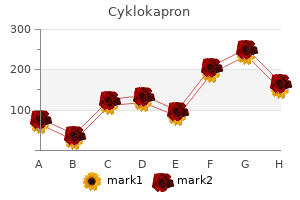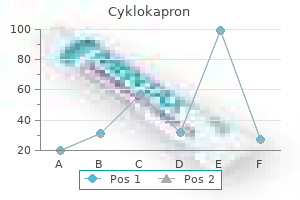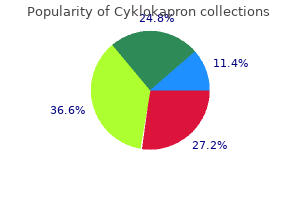"Generic cyklokapron 500mg, treatment 0f ovarian cyst."
By: Bob Atkins
- Emeritus Professor, Epidemiology & Prev Med Alfred Hospital
https://research.monash.edu/en/persons/bob-atkins
Other fluoroquinolones medicine merit badge buy generic cyklokapron 500mg, corresponding to moxifloxacin and garenoxacin medications on carry on luggage cyklokapron 500 mg on line, with elevated anaerobic activity could represent a possible monotherapy option sooner or later medications during pregnancy quality 500mg cyklokapron. Empiric antimicrobial remedy for cholangitis and cholecystitis ought to be initiated after blood cultures have been collected medications mobic cheap cyklokapron 500mg on line. The empiric choice of remedy should cowl enteric gram-adverse pathogens, notably E. The addition of anaerobic protection is usually really helpful, notably for patients with cholangitis and aged patients with previous biliary tract interventions. Antimicrobial remedy should be guided by drug pharmacokinetics and pharmacodynamics, native resistance patterns, and affected person elements, corresponding to drug allergies, renal or hepatic dysfunction, and value. Examples of applicable empiric regimens embody combination remedy with an extended spectrum cephalosporin (ceftriaxone, cefotaxime, or cefepime) or an aminoglycoside, plus metronidazole, or a fluoroquinolone (ciprofloxacin or levofloxacin) plus metronidazole. These authors concluded that biliary excretion of any antibiotic is minimal in the presence of obstruction. Primary peritonitis entails the development of infection in the peritoneal cavity in the absence of intraabdominal abnormality. Tertiary peritonitis describes medical peritonitis along with indicators of sepsis and multiorgan dysfunction that persist or recur following the treatment of secondary peritonitis. Bacteria will then infect the ascitic fluid by hematogenous or lymphogenous unfold. Bacterial overgrowth in the face of decreased motility and elevated intestine wall permeability, secondary to structural damage, facilitates subsequent systemic infection. What is an applicable period of remedy, and the way should the response to remedy be monitored? Ampicillin plus an aminoglycoside historically was used as empiric remedy; however, third-technology cephalosporins (cefotaxime and ceftriaxone) or -lactam�-lactamase inhibitor mixtures (ampicillin� sulbactam) as monotherapy represent safer, possibly more effective choices. After treatment is accomplished, should prophylactic antimicrobial remedy be initiated in M. The doctor asks if the brokers chosen for treatment and prophylaxis of peritonitis in M. What properties determine the penetration of antibiotics into the peritoneal fluid? The aim of this remedy is to reduce the burden of micro organism and subsequently stop bacterial translocation and therefore infection. The brokers studied embody oral norfloxacin,22 ciprofloxacin,23 and trimethoprim�sulfamethoxazole. In one study evaluating the influence of prophylactic norfloxacin (400 mg/day) on fecal flora, fluoroquinolone-resistant isolates developed during treatment. Rates of fluoroquinolone-resistant and trimethoprim� sulfamethoxazole-resistant gram-adverse bacilli have turn into extra prevalent in patients who receive long-term prophylactic remedy. Prophylactic antimicrobial remedy ought to be thought-about and may be a cheap measure. Any of the aforementioned prophylac- the penetration of antimicrobial brokers into tissues or abscess cavities depends on the serum-to-tissue fluid focus gradient; the binding of the antimicrobial to serum and tissue proteins; the diffusibility of the drug, based mostly on its molecular measurement and acid dissociation fixed (pKa); and lipid solubility. Pathogenesis and Clinical Presentation Peritonitis continues to remain a major complication of peritoneal dialysis. An estimated 45% of patients undergoing continuous ambulatory peritoneal dialysis will expertise a minimum of one episode of peritonitis in the first 6 months of dialysis. Approximately 60% to 70% of patients develop peritonitis during the first yr of dialysis, and recurrent infection occurs in 20% to 30% of patients. Nausea and vomiting occur in roughly 30% of patients, whereas 10% could have diarrhea, and 10% to 20% will current with fever. The diagnosis of peritonitis is made based mostly on medical indicators and signs along with examination of the dialysate fluid for cell counts, Gram stain, and tradition. Initial remedy recommendations embody vancomycin or a first-technology cephalosporin for gram-constructive protection with an applicable antibacterial agent for gram-adverse protection. An rising prevalence of fluoroquinolone-resistant gram-adverse organisms, notably E. Antibiotic remedy is really helpful for a minimum of 2 weeks and even longer in severe circumstances.

Only a couple of monitors report complete blood glucose; in these monitors treatment 0 rapid linear progression cheap 500 mg cyklokapron, capillary values measured are likely to medicine daughter purchase 500 mg cyklokapron mastercard be 10% to treatment vitiligo discount cyklokapron 500 mg fast delivery 15% lower than values measured by the laboratory symptoms 7dp5dt buy cyklokapron 500mg otc. Patient education relating to coding procedures, testing procedures, the importance of recording outcomes, and check instances are critical. Used correctly, out there monitors present correct, precise outcomes that can be utilized by patients to handle their diabetes. However, several elements can have an effect on the accuracy of monitor outcomes-most commonly, gear malfunction and human error. Problems with a monitor could be detected by performing a quality-control check once weekly and with each new vial of strips; human error could be minimized with adequate coaching. Most practitioners suggest no less than premeal and bedtime blood glucose testing (no less than 4 instances daily). The goal of ongoing, frequent blood glucose testing is to determine whether or not normoglycemia is being achieved and to assess the motion of specific insulin doses as well as the impression of meals, food, illness, or exercise on blood glucose ranges. Ideally, patients should check their blood glucose concentration before meals, 90 to one hundred twenty minutes after meals to assess postprandial glycemic control and to determine their "insulin to carbohydrate ratio," at bedtime, and infrequently, at 2 or 3 am. This could imply the higher limits of the appropriate concentrations could also be excessive initially. Only adjust insulin doses if a pattern of response is observed beneath stable food plan and exercise circumstances. Unless all ranges are >200 mg/dL, attempt to adjust one element of insulin therapy at a time. Start with the insulin element affecting the fasting blood glucose concentration. This glucose stage usually is probably the most difficult to control and often affects all other glucose concentrations measured all through the day. Table 50-18 Factors That Can Alter Self-Monitored Blood Glucose Test Results: Troubleshooting Glucose monitor not coded for batch of check stripsa An insufficient quantity of blood applied to check stripb Dirty glucose monitora Low batterya Test performed outside of temperature and humidity working conditionsa Lowc or highb hematocrit Dehydrationb Hyperosmolar, nonketotic stateb Lipemiaa High ranges of ascorbic acid or salicylates (rare)b a b Effect unpredictable. Supplementary Insulin Doses Once the fundamental dose of insulin has been established, supplemental doses of speedy- or quick-acting insulin could be prescribed to appropriate preprandial hyperglycemia. For instance, if the objective is a hundred and forty mg/dL, and the glucose value is a hundred ninety mg/dL, administer one extra unit. If premeal glucose concentrations are <60�70 mg/dL, the dose of lispro, aspart, glulisine, or regular insulin administered before the meal is by 1�2 U; insulin administration is delayed till just before the meal; the meal should embrace an extra 15 g of glucose if the value is <50 mg/dL. If supplemental doses before a given meal are required for 3 days, the fundamental insulin dose ought to be adjusted appropriately. For instance, if a patient taking lispro before meals requires an extra 2 items before lunch for 3 days, 2 items ought to be added to the prebreakfast dose. When blood glucose is tested much less incessantly than 4 instances daily, glucose control deteriorates to baseline ranges. She was requested to check her blood glucose 4 instances daily (before meals and at bedtime), to report her outcomes and other unusual events or symptoms in the course of the day, and to convey her information to the clinic. The initial objective of therapy is to obtain preprandial blood glucose concentrations of <a hundred and eighty mg/dL and to get rid of symptoms of hyperglycemia. Time 7 am Noon 5 pm eleven pm Anticipatory Insulin Doses the fundamental insulin dose is elevated or decreased based mostly on the anticipated results of food plan or bodily activity. Increase lispro/aspart/glulisine or regular insulin by 1 unit for each extra 15 g of carbohydrate ingested. She additionally should set her alarm for 3 am two or thrice per week and check her blood glucose. Increasingly, patients who use Glucose Concentration (mg/dL) one hundred sixty�200 220�260 130�a hundred and eighty a hundred and forty�a hundred and eighty mmol/L eight. She eats roughly 4 carbohydrate servings for breakfast (60 g) and two to 4 carbohydrate servings for lunch and dinner (30�forty five g). Table 50-19 Diet Factors That Can Alter Blood Glucose Control Health care suppliers should use the information obtained from selfmonitoring to (a) set glycemic goals, (b) develop recommendations for pharmacologic therapy, (c) evaluate the effectiveness of pharmacologic therapy, (d) instruct patients to interpret and reply to blood glucose patterns, (f) evaluate the impression of dietary elements on glycemic control, (g) modify therapy during acute/intercurrent illness or whenever patients receive drugs known to have an effect on glycemic control, (h) modify the management plan in response to a change in activity ranges, and (i) establish hypoglycemic unawareness.

Predisposing components for hematogenous osteomyelitis embrace any risk components that promote bacteremia treatment skin cancer generic cyklokapron 500mg on line. A distant focus within the gastrointestinal or urinary tract can result in medicine jar buy cyklokapron 500mg cheap bacteremia and predispose a affected person to treatment upper respiratory infection cheap cyklokapron 500 mg without a prescription the development of osteomyelitis medications for depression order cyklokapron 500mg on-line. Patient interviews, discussions with his parents, and a comprehensive evaluation of his medical report are needed, especially if a historical past of allergy is reported. Details of an allergic response, including symptoms, onset of the response, probable causative agent, remedy, and publicity to related compounds, must be sought. Cultures of blood and bone aspirate materials are the best methods to identify the precise bacterial cause for osteomyelitis and are sometimes a part of the preliminary workup. Cultures taken after antibiotics are began often are negative, nonetheless, thereby necessitating the usage of empiric broad-spectrum antibiotic therapy for several weeks. If the blood cultures had been negative, nonetheless, a bone aspirate for culture to identify the pathogen would be beneficial. What is the relevance of bone concentrations or protein binding of antibiotics within the selection of therapy for osteomyelitis? It is necessary to provoke remedy as soon as possible to improve the chances for complete eradication of an infection and to avoid the necessity for surgery. Thus, empiric antibiotic therapy often is instituted earlier than culture and sensitivity outcomes are known. In the absence of susceptibility outcomes or if the isolate is oxacillin-resistant, therapy would proceed with vancomycin. Other organisms that may cause osteomyelitis embrace Staphylococcus epidermidis, Streptococcus pyogenes, Streptococcus pneumoniae, Haemophilus influenzae, and P aeruginosa. His prior publicity to amoxicillin is irrelevant except to set up the absence of a penicillin allergy. Under circumstances of negative cultures or whereas blood or bone cultures are pending, the age of the child with acute osteomyelitis is necessary within the selection of applicable empiric antibiotics. Table 66-2 summarizes beneficial drugs and dosages in kids with acute osteomyelitis. In addition, cefazolin and ceftriaxone, two highly protein-certain drugs, normally are efficient in treating osteomyelitis, provided excessive dosages are given for an ex- tended period, and the responsible pathogen is vulnerable. Is oxacillin the best antibiotic choice, or would different antibiotics, given much less regularly, even be enough therapy? Antistaphylococcal penicillins achieve excessive levels in bone and normally present efficient therapy when the remedy regimen is followed with frequent doses for an enough period. What is an applicable dosing regimen, and the way often should he return to the clinic for evaluation? Dosages of oral antibiotics for kids with osteomyelitis are summarized in Table 66-3. The postoperative course was unremarkable till yesterday, when he developed right leg pain and spontaneous drainage from the surgical wound. Few of the systemic indicators and symptoms normally related to acute osteomyelitis are seen in secondary osteomyelitis. The commonest subjective grievance in acute contiguous osteomyelitis is pain within the area of an infection, which often is accompanied by localized tenderness, swelling, erythema, and drainage. Because several weeks might pass earlier than the affected person becomes symptomatic, radiographic studies on the time of analysis might reveal abnormalities according to bone deterioration. In these instances, bone becomes contaminated from an exogenous supply, or through unfold of an an infection from adjoining tissue to bone. Infection may end up from any trauma followed by an orthopedic procedure to fix a bone fracture. These embrace any penetrating harm, such as a gunshot wound or a nail puncture, or gentle tissue infections, such as stress sores or these involving the fingers and toes. Unlike hematogenous osteomyelitis, which occurs mostly in kids, acute contiguous an infection occurs extra often in adults. This is defined by the upper incidence of precipitating components inside this age group, such as hip fractures, orthopedic procedures, oral cancers, sternotomy incisions for cardiac surgery, and craniotomies.

Intravenous phosphate repletion regimen for critically ill patients with moderate hypophosphatemia mueller sports medicine cheap cyklokapron 500mg amex. Hyperglycemia related to excessive medicine 5325 cheap cyklokapron 500mg, continuous infusion rates of complete parenteral diet treatment laryngomalacia infant buy generic cyklokapron 500 mg line. Management of hyperglycemia in hospitalized patients receiving parenteral diet 5 medications cyklokapron 500mg line. Outcome good thing about intensive insulin remedy in the critically ill: insulin dose versus glycemic control. Continuous intravenous insulin infusion reduced the incidence of deep sternal would an infection in diabetic patients after cardiac surgical procedures. Glucose control lowers the chance of wound an infection in diabetics after open coronary heart operations. Pulmonary deposition of calcium phosphate crystals as a complication of home parenteral diet. Nutritional remedy with branched-chain amino acids in superior liver cirrhosis. Overview of randomized scientific trials of oral branched-chain amino acid remedy in continual hepatic encephalopathy. Metabolic and nutritional features of acute renal failure in critically ill patients requiring continuous renal replacement remedy. Continuous arteriovenous hemodiafiltration in the critically ill: influence on main nutrient balances. Glucose dynamics during continuous hemodiafiltration and complete parenteral diet. The main function of the pores and skin is to protect underlying buildings from trauma, temperature variations, dangerous penetrations, moisture, humidity, radiation, and invasion of micro-organisms. There are three layers of pores and skin: the dermis, the dermis, and subcutaneous tissue. This layer retains chemicals and other substances from penetrating into the physique and prevents the loss of water from the pores and skin and underlying tissues. The maturation of keratinocytes from the stratum germinativum to the stratum corneum is important for this barrier function. The capillary community plays a significant role in temperature regulation and provides diet to the dermis. Finally, the dermis contains large amounts of water, thus serving as a water storage organ. All however probably the most superficial accidents to the dermis usually result in scarring as the wound heals. Generally, only small amounts of topically utilized medication enter the dermis via the sweat glands or the pilosebaceous units. Subcutaneous Layer the subcutaneous layer helps the dermis and dermis, and serves as a fats storage area. This layer helps regulate temperature, provide nutritional assist, and cushion the outer pores and skin layers. The selection of auto for continual lesions is often based on what the affected person has found to work best or is keen to use. Frequently, patients with continual dermatologic conditions use a number of kinds of vehicles concomitantly. Acute Lesions migrate to the pores and skin floor, they alter from residing cells to dead, thick-walled, nonnucleated cells containing keratin, a hard fibrous protein. It normally takes 26 to 28 days for a keratinocyte to divide, differentiate, move as much as the stratum corneum, and be sloughed off. The stratum corneum, which is composed of the dead cells, provides the best resistance to the percutaneous absorption of chemicals and medicines. It behaves as a semipermeable membrane via which medication are absorbed by passive diffusion. Factors that may affect drug absorption are hydration of the pores and skin and damage to the stratum corneum. In general, the greater the damage to the stratum corneum, the greater is the absorption of topically utilized medication.
Discount 500mg cyklokapron free shipping. Influenza Virus The Deadly Flu Signs Symptoms Treatments HD.
References:
- https://www.choc.org/wp/wp-content/uploads/2020/11/spontaneous-pneumothorax-ph-with-references.pdf
- https://www.kidney.org/sites/default/files/01-10-7201.pdf
- https://pdfs.semanticscholar.org/ad7c/d2035fa5c35044dc062d177eed23ec29fab7.pdf

